Jersey- Anticlockwise and then clockwise around the island (60 miles).
 Jersey is the largest of the Channel Islands, between England and France. A self-governing
dependency of the United Kingdom, with a mix of British and French cultures, it’s best known for
its beaches, WW2 fortifications, historic castles, and tasty dairy products.
Jersey is the largest of the Channel Islands, between England and France. A self-governing
dependency of the United Kingdom, with a mix of British and French cultures, it’s best known for
its beaches, WW2 fortifications, historic castles, and tasty dairy products.
I have an extensive cycling trip planned abroad in May and needed a quick trip overseas to iron out any difficulties flying with the bike- so the expedition to Jersey in January 2017 was born. Slightly deviating from just describing the ride itself, I thought it would be useful to describe the perils of flying with a bike; so here it is- I choose to fly from Cardiff as it was near to my home town, and I debated getting there by various modes of transport, finally settling with the car. Prior to choosing the flight, I looked at the various airline weight limits allowed and choose Flybe- ‘Flybe’ hasn’t got a specific price for cycles, so I had to pay for two twenty kilo hold bags, one of which could be a maximum of thirty kilos. ‘Flybe’ was the right price, but even after paying for the hold luggage, they suggested they would only take the bike if there was enough room in the hold (quite off putting), but I was assured "it shouldn’t be a problem in January". Each airline has different policies about taking bikes on aeroplanes, so it’s worth scrutinising the small print with your chosen airline company.
At home, it took me ages trying to fit the bike into the bag (at this point it’s important to stress- I’m no stranger to flying all over the world with a bike, but that was a long time ago and it was with a ‘track bike’ which weighed as much as a chicken in the basket), my bike is meant for touring and has full mudguards, lights, gadgets, and pannier racks; I’d take a piece off, then try it in the bag, take another piece off and try it again, eventually I got it in. The bike bag just fitted into my little car, that is; if you didn’t mind resting it on your shoulder for the journey.
Day 1- Cardiff to Jersey (the flight).
 I was told to arrive early as the bike would need to go through the overweight bag security and this may
take some time when the airport is busy. As instructed by ‘Flybe’, I arrived early for my flight. Struggling
with the bike bag and small trolley suitcase, I entered the departures area, and was befuddled by the desertion
of staff; I’ve flown out of busier third world country airports. There was one (very bored) woman pushing one of
those massive ‘V’ shaped mops along the floor, and no one else could be seen. The check in area was fully
automated ‘self service’. Okay; I had a go and printed out a label for my bag, then took it to the oversize
bag door. There, I was met by a buxom lady (who was obviously used to handling heavy weights). “I can’t accept
this love (in a broad Welsh accent) until it’s been weighed.”
I was told to arrive early as the bike would need to go through the overweight bag security and this may
take some time when the airport is busy. As instructed by ‘Flybe’, I arrived early for my flight. Struggling
with the bike bag and small trolley suitcase, I entered the departures area, and was befuddled by the desertion
of staff; I’ve flown out of busier third world country airports. There was one (very bored) woman pushing one of
those massive ‘V’ shaped mops along the floor, and no one else could be seen. The check in area was fully
automated ‘self service’. Okay; I had a go and printed out a label for my bag, then took it to the oversize
bag door. There, I was met by a buxom lady (who was obviously used to handling heavy weights). “I can’t accept
this love (in a broad Welsh accent) until it’s been weighed.”
“How do I weigh it, when there’s no-one at the checkin counter?”
“You’ll just have to wait until someone comes…..(pause).. Love”
 So I waited (with the apathetic woman pushing the big ‘V’ mop), and waited, and waited. People
without big cumbersome bike bags- used the automated checkin, and went on to departures security, and
I smiled at them as they went past, and they smiled back in a manor saying- ‘you should use the
automated checkin mate’. Finally someone turned up at the checkin desk, they weighed the bike and said,
“Have you deflated the tyres?”
So I waited (with the apathetic woman pushing the big ‘V’ mop), and waited, and waited. People
without big cumbersome bike bags- used the automated checkin, and went on to departures security, and
I smiled at them as they went past, and they smiled back in a manor saying- ‘you should use the
automated checkin mate’. Finally someone turned up at the checkin desk, they weighed the bike and said,
“Have you deflated the tyres?”
“Yes” (I said with a lack of concern), but I hadn’t as I couldn’t be bothered to re-inflate them with my mini-pump at the other end. Anyway, I headed back to the buxom woman in the overweight baggage area, this time she accepted the bike.
On arrival in Jersey, I dragged the bike bag and my suitcase to ‘Europcar’ and handed over my driving license. I could see the woman deliberating how it could be possible for such a large bag to fit into the ‘mini car’ I’d pre-ordered. She asked, “Do you require an upgrade to a bigger car?”
 “No thank you”, and with the keys to the car I struggled out of the airport with my
luggage (should’ve used a trolley), found the car
and jammed the baggage in. I got it in, but I had to drive with my head tilted at 45°. I was
staying at the ‘Nicole tower’, a ninetieth century folly (with earlier foundations) converted into a
Nazi WW2 observation tower during the occupancy of the Islands- how cool was that? I did have
instructions on how to get there, but like any man; I didn’t follow them. I stopped off at a shop
to ask for directions, but the French proprietor just shrugged her shoulders and emitted a nonchalant
"Burf" sound (very stereotypical I know, but it happened). As luck would have it, it was a Yorkshire
man who pointed me in the right direction. Well, ‘Nicole tower’ was up a sidetrack of a road, then up
a tiny rough lane. Completely in the dark I fuddled with the keys and opened the front door; it had
the footprint of a large paddling pool, but looked very bijou. That aside, the views were immense.
With the whole area devoid of street lights, the stars were crystal clear and brilliant. I opened a
bottle of red and sat there admiring the panorama.
“No thank you”, and with the keys to the car I struggled out of the airport with my
luggage (should’ve used a trolley), found the car
and jammed the baggage in. I got it in, but I had to drive with my head tilted at 45°. I was
staying at the ‘Nicole tower’, a ninetieth century folly (with earlier foundations) converted into a
Nazi WW2 observation tower during the occupancy of the Islands- how cool was that? I did have
instructions on how to get there, but like any man; I didn’t follow them. I stopped off at a shop
to ask for directions, but the French proprietor just shrugged her shoulders and emitted a nonchalant
"Burf" sound (very stereotypical I know, but it happened). As luck would have it, it was a Yorkshire
man who pointed me in the right direction. Well, ‘Nicole tower’ was up a sidetrack of a road, then up
a tiny rough lane. Completely in the dark I fuddled with the keys and opened the front door; it had
the footprint of a large paddling pool, but looked very bijou. That aside, the views were immense.
With the whole area devoid of street lights, the stars were crystal clear and brilliant. I opened a
bottle of red and sat there admiring the panorama.
Day 2- Anticlockwise around the east coast of Jersey (25 miles).
 I put the bike together and set off, it was 5°C and there was a heavy frost (unheard of in Jersey), but the sun was
shining and it felt quite warm. I set off for Grouville trying to capture an image of every tower I
came across (a hopeless task as there are so many of them). The main roads are narrow with small boundary walls
(the side roads are even narrower!), drivers are courteous, but maybe
they’re a bit over cautious as they sit behind you for ages (better that I suppose than clipping
you with the wing mirrors like in the UK). Onto Mont Orgueil castle, a fantastic spectacle rising
from a spit in the land, then up. Following the Jersey coast reminded me of Cornwall (ball breaking up and
down), descending down one side of a cove, onto a beach and then back up the hill on the other side of
the bay. Next it was St Catherines Bay (a large sandy bay) which led onto a one way system, where I was
exposed my first WW2 bunker (or gun emplacement) now a turbot farm of all things.
I put the bike together and set off, it was 5°C and there was a heavy frost (unheard of in Jersey), but the sun was
shining and it felt quite warm. I set off for Grouville trying to capture an image of every tower I
came across (a hopeless task as there are so many of them). The main roads are narrow with small boundary walls
(the side roads are even narrower!), drivers are courteous, but maybe
they’re a bit over cautious as they sit behind you for ages (better that I suppose than clipping
you with the wing mirrors like in the UK). Onto Mont Orgueil castle, a fantastic spectacle rising
from a spit in the land, then up. Following the Jersey coast reminded me of Cornwall (ball breaking up and
down), descending down one side of a cove, onto a beach and then back up the hill on the other side of
the bay. Next it was St Catherines Bay (a large sandy bay) which led onto a one way system, where I was
exposed my first WW2 bunker (or gun emplacement) now a turbot farm of all things.
I had to back track up a substantial hill where I followed route 1 again sending me down into a tiny cove. Going downhill this time was pretty scary, as I could hear the road ice cracking under my wheels where a stream ran across the road. At sea level, stood the Fliquet tower with a small German bunker next it. Climbing again quite steeply, but not for long I was on winding roads devoid of traffic until I passed Durrell wildlife park and back down again into Rozel bay an unimposing little cove.
 Unless I was going potty none of the towers, or forts are signposted, but luckily I’d done my homework and I knew where they were. I
was heading for L'Etacquerel Fort down a single track path and there it was; a small wooden bridge led
to a locked wooden door. I was disappointed with the fort being locked, I looked it up when I got
back, it’s not open to the public, but it is available for hire for bar mitzvah’s and weddings. Next
was Fort Leicester down another steep hill into Bouley bay, again this was a holiday residence so I
couldn’t visit it, and though I moan, I can understand it; get holidaying people to pay for the upkeep
of old structures or get the State to pay for them? After all, I was paying to stay in Nicole Tower.
After a coffee in the Waters Edge Hotel (a rather large hotel for a little inlet) it was back up a
vertical (it felt like it) climb. I turned south into Trinity and passed Trinity church a somewhat
ugly minster where it looked like the steeple was added later in concrete because they’d forgot
about it. I cut Jersey in half by travelling on the A8, which had roadworks halfway along forcing me
to walk on the pavement (I did ride some of it). Now I was heading downhill into St Helier and then
east to go back to Nicole tower.
Unless I was going potty none of the towers, or forts are signposted, but luckily I’d done my homework and I knew where they were. I
was heading for L'Etacquerel Fort down a single track path and there it was; a small wooden bridge led
to a locked wooden door. I was disappointed with the fort being locked, I looked it up when I got
back, it’s not open to the public, but it is available for hire for bar mitzvah’s and weddings. Next
was Fort Leicester down another steep hill into Bouley bay, again this was a holiday residence so I
couldn’t visit it, and though I moan, I can understand it; get holidaying people to pay for the upkeep
of old structures or get the State to pay for them? After all, I was paying to stay in Nicole Tower.
After a coffee in the Waters Edge Hotel (a rather large hotel for a little inlet) it was back up a
vertical (it felt like it) climb. I turned south into Trinity and passed Trinity church a somewhat
ugly minster where it looked like the steeple was added later in concrete because they’d forgot
about it. I cut Jersey in half by travelling on the A8, which had roadworks halfway along forcing me
to walk on the pavement (I did ride some of it). Now I was heading downhill into St Helier and then
east to go back to Nicole tower.
Day 4- Clockwise around the west coast of Jersey (35 miles).
What happened to day 3? Well the weather was crap and I locked myself in the tower (as in the millers daughter in Rumpelstiltskin) as I had work to do, which I hasten to add wasn’t spinning gold. In the night I didn’t get much sleep as the wind howled through the ornate windows like a hammer house horror film.
 On day 4, most of Europe was cloudy and experiencing inches of deep snow. Jersey had radiant sunshine, but it was
3°C, with a bitter arctic wind, which made it much colder. I set off around ten, and dropped down near the St Helier
old harbour to see the first castle of the day- Elizabeth castle. Now heading west out of St Helier
there was a substantial tailwind, I rode along the cycle path next to Victoria avenue which
hugged the shoreline. It seems ‘Jersey Beans’ (a nickname for the people of Jersey, which was banned
in 2014) love painting as the cycle path has two white lines either side which glided symmetrically around
every obstacle. The path took me past a German bunker menacingly aimed at the beach, close by was
the station café. Yes, Jersey did have a railway, it ran along the south coast from one side of the island
to the other (in east and west sections). It closed in 1936 much to Hitlers displeasure (he just missed
out), so he reopened the west route again in June 1940 to carry the materials to fortify the island.
On day 4, most of Europe was cloudy and experiencing inches of deep snow. Jersey had radiant sunshine, but it was
3°C, with a bitter arctic wind, which made it much colder. I set off around ten, and dropped down near the St Helier
old harbour to see the first castle of the day- Elizabeth castle. Now heading west out of St Helier
there was a substantial tailwind, I rode along the cycle path next to Victoria avenue which
hugged the shoreline. It seems ‘Jersey Beans’ (a nickname for the people of Jersey, which was banned
in 2014) love painting as the cycle path has two white lines either side which glided symmetrically around
every obstacle. The path took me past a German bunker menacingly aimed at the beach, close by was
the station café. Yes, Jersey did have a railway, it ran along the south coast from one side of the island
to the other (in east and west sections). It closed in 1936 much to Hitlers displeasure (he just missed
out), so he reopened the west route again in June 1940 to carry the materials to fortify the island.
I climbed out of St Aubins (originally a fishing village) on part of the old railway now converted
into a cycle path, St Aubins fort could be seen on a secluded rock in the bay below, at the top I turned
left onto a tiny road (through a farm) and onto Noirmont point. Here, I was blown away (forgive the pun)
by the amount of German gun emplacements and bunkers. Hitler declared that the Channel Islands would
become an impregnable fortress and he wasn’t bullshiting, and
 though I couldn’t hold my excitement, I knew it was with a certain paradox of sadness, as the whole complex was
built with slave labour, where many prisoners of war died building it. I walked to the end of the headland
and a Navy watch tower loomed from below, sunk into the cliff face was
Marine Peilstand tower one or Naval direction-finding tower, this was one of three constructed in Jersey, out of a
planned total of nine. Back from MP1 was loads of bunkers and gun emplacements strategically placed each
side of the peninsula, all connected by a series of concrete trenches. The gun in the image above faced St
Helier and could easily reach the far shore.
though I couldn’t hold my excitement, I knew it was with a certain paradox of sadness, as the whole complex was
built with slave labour, where many prisoners of war died building it. I walked to the end of the headland
and a Navy watch tower loomed from below, sunk into the cliff face was
Marine Peilstand tower one or Naval direction-finding tower, this was one of three constructed in Jersey, out of a
planned total of nine. Back from MP1 was loads of bunkers and gun emplacements strategically placed each
side of the peninsula, all connected by a series of concrete trenches. The gun in the image above faced St
Helier and could easily reach the far shore.
Cycling down into St Brelade's Bay was another martello tower, but more importantly this little sandy cove was something else; it’s Jerseys worst ‘best kept secret’. The South facing bay is reputed to be sheltered from everything but slight onshore breezes, and considering the wind was howling on the headlands, I guess the reputation was pleasantly correct. I could see the white horses out to sea, but here it barely pushed a chap’s e-cigarette smoke away. As soon as I went up the hill again, the glacial wind blasted me along.
I dropped down to Ouaisné bay and like many bays in Jersey its small, but there was another tower- ‘Ouaisné Tower’. I needed a drink to warm up, and I stopped at a small kiosk, the hot milky coffee went some way to abating the cold. At Corbière headland was the second Marine Peilstand tower, this one had been converted into a holiday let, set on the cliff top overlooking Corbière lighthouse. I walked down the lighthouse causeway, what a great picture this made with the blue waves crashing against the sharp craggy rocks, sending spray high into the air. I can’t describe how fantastic the view was, but alas the price for that vista was a bitter biting wind, so sharp it cut me like razor blades. I had to move on and find the next hot drink.
 Downhill again, was St Ouens (doesn’t there seem to be a lot of saints in Jersey?),
a two mile long beach with another tower- La Rocco Tower at the southern end of the beach (and you
guessed it) it’s been converted into a holiday let accommodating up to six people plus a guide (as
it’s completely surrounded by sea twice a day). It stands on a rocky outcrop half a mile offshore,
perfect for anyone looking for adventure (or those who can afford it). I had another hot drink at
the Le Bray café and I know stopping and starting probably made things worse, but today was
exceptionally cold (colder than my first trip to Poole in 2013).
Downhill again, was St Ouens (doesn’t there seem to be a lot of saints in Jersey?),
a two mile long beach with another tower- La Rocco Tower at the southern end of the beach (and you
guessed it) it’s been converted into a holiday let accommodating up to six people plus a guide (as
it’s completely surrounded by sea twice a day). It stands on a rocky outcrop half a mile offshore,
perfect for anyone looking for adventure (or those who can afford it). I had another hot drink at
the Le Bray café and I know stopping and starting probably made things worse, but today was
exceptionally cold (colder than my first trip to Poole in 2013).
 Now there was bunker after bunker set into the sea wall, with most of them converted into
private accommodation or surf outlets, at the northern end of the beach was the Channel Islands
military museum, but it was shut. After riding along flat roads at sea level for two miles, I made
a heavenly ascent (meaning it just kept going up). At Les Landes was 'Battery Moltke' overlooking the
very beach I’d been riding along. On permanent display is one of the original French field guns from
the battery, initially pushed over the nearby cliffs by the British Army in 1946, and then retrieved
and restored in the 1990s.
Now there was bunker after bunker set into the sea wall, with most of them converted into
private accommodation or surf outlets, at the northern end of the beach was the Channel Islands
military museum, but it was shut. After riding along flat roads at sea level for two miles, I made
a heavenly ascent (meaning it just kept going up). At Les Landes was 'Battery Moltke' overlooking the
very beach I’d been riding along. On permanent display is one of the original French field guns from
the battery, initially pushed over the nearby cliffs by the British Army in 1946, and then retrieved
and restored in the 1990s.
At this point, I was bloody freezing, shivering like a shitting puppy, but I had a few more landmarks to see before heading back- Grosnez castle and Marine Peilstand tower number three (MP3). The castle was accessible past Jersey racecourse and was by definition; a pile of rubble (with some walls standing), but it’s vantage was overwhelming looking out at the Atlantic sea. The forboding MP3 was just along the headland along a coastal path, with its own protective bunkers nearby.
I retraced my steps back to the main road and rode on, gladly coming across café Ouen, set in a little farmyard. Here I ordered soup and warmed myself under the toilet hot air hand dryer. After some time thawing out the dew drop on the end of my nose I set off again, I knew there was another bunker at Plémont and remnants of a massive holiday camp only half a mile to the left, so I went right (there was only so many WW2 relics I could take). At Gréve de Lecq I went around a tower and back up a hill (without stopping). That was it, I’d had enough, the freezing conditions had taken their toll; the hills were getting on my nerves, the cold was getting on my nerves, the now headwind was getting on my nerves, the mini winding roads were getting on my nerves. At St John (another bloody saint) I turned inland and headed for St Helier then back to Nicole tower which was ironically; up another soding hill. I could hardley co-ordinate my legs to rotate, so I walked up it, and yes, I was grouchy! When I got to the front door, I could barely put the keys in the lock.
I had a tepid bath (as I couldn’t stand the hot water) after which I put every dry layer of clothes on I could find, my skin itched like crazy, I don’t think I’ve ever been so cold in my life. On reflection I should have stayed at St Brelade's Bay, caught the bus back to Nicole tower, and driven around the rest of the island. I guess my downfall was a mixture of; drooling over the entire Jersey heritage, sweating going up the inclines, cooling down on the descents, and then stopping to take photos of every historic construction, not wanting to miss anything even in the penetrating cold, and the result- Hypothermia in four easy steps.
What a place, Jersey has it all- fantastic beaches, castles, and a massive WW2 presence, and despite the dangerous drop in body temperature- I loved every minute of it.
-
Gallery
 Why not have a look at the gallery relating to this ride. Click the image or the title.
Why not have a look at the gallery relating to this ride. Click the image or the title. -
Top tips for flying with a baby
 No sooner had the plane taken off
I heard a high-pitched shriek, but it wasn't engine failure, emerging from two rows behind
me was a two foot high screaming banshee. Thankfully the flight was only forty minutes.
No sooner had the plane taken off
I heard a high-pitched shriek, but it wasn't engine failure, emerging from two rows behind
me was a two foot high screaming banshee. Thankfully the flight was only forty minutes.
Tip No.1- Leave them at home.
Tip No.2- Leave them at home.
Tip No.3- follow rule 1. -
Deflating tyres for a flight
I can never understand this need to deflate tyres before a flight. Firstly, the cargo hold of a commercial jet is at the same pressure as the cabin, and even if it wasn’t, the pressure difference between ground level and the max height of the plane is nowhere near enough to blow a tyre off a rim, and anyway the hold isn’t heated which offsets the pressure difference. Whew! I was getting a bit technical there.
-
Nicole tower
 Nicolle Tower was built as a folly in 1821 with a pretty sitting room on the first floor. The
tower has gone through at least three separate phases of construction; most recently in 1943
when the Germans raised the roof by one storey.
Nicolle Tower was built as a folly in 1821 with a pretty sitting room on the first floor. The
tower has gone through at least three separate phases of construction; most recently in 1943
when the Germans raised the roof by one storey.
 During WW2 the tower served as an important lookout and range finder for the German gun battery
protecting the east side of the island. In the image, you can just see the compass bearings on the ceiling,
and on the walls were approximate distances to targets.
During WW2 the tower served as an important lookout and range finder for the German gun battery
protecting the east side of the island. In the image, you can just see the compass bearings on the ceiling,
and on the walls were approximate distances to targets.
There are five bunkers surrounding the tower, built to defend against any ground attack. Two south facing bunkers were easily accessible, but only one could be entered safely. The other three were on the side of a steep hill and overgrown with brambles. -
Seymour tower
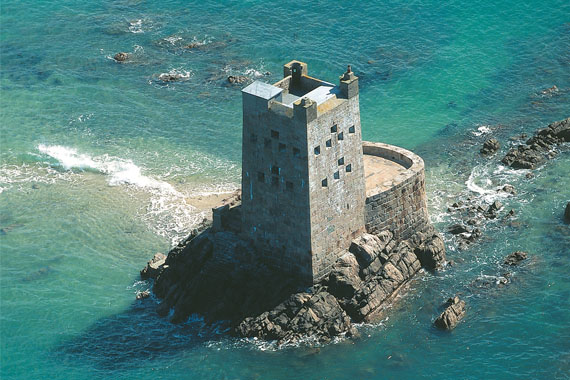 The Seymour Tower was constructed in 1782, built on a rocky tidal island called L'Avarison
and is located 2 km east off the shoreline. Its one of thirty coastal towers planned, however
only 23 towers were built. Jersey Heritage now operates the tower as a holiday rental, but it
hasn't got toilets so you have to bring your poo back with you.
The Seymour Tower was constructed in 1782, built on a rocky tidal island called L'Avarison
and is located 2 km east off the shoreline. Its one of thirty coastal towers planned, however
only 23 towers were built. Jersey Heritage now operates the tower as a holiday rental, but it
hasn't got toilets so you have to bring your poo back with you. -
Fliquet Tower
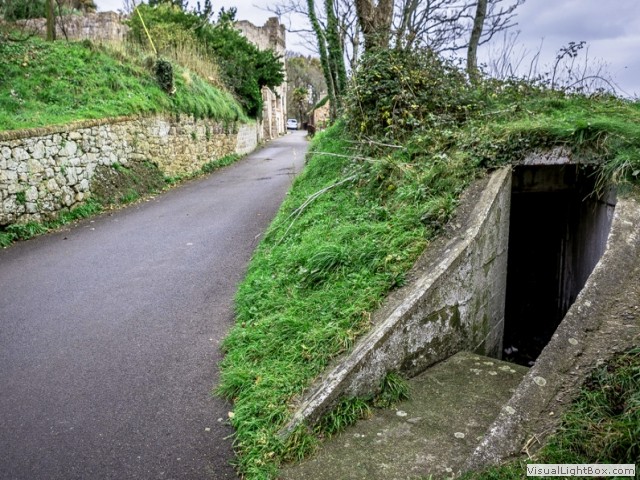 One of the 23 Conway towers built, this one was nicknamed the ‘Telegraph tower’ because
a telegraph cable from France came ashore here. It was still an important communications
link during the occupation and was protected by a German resistance nest comprising of machine
gun posts and a bunker (shown above). Just along from here was an interesting private residence
in the shape of a small castle.
One of the 23 Conway towers built, this one was nicknamed the ‘Telegraph tower’ because
a telegraph cable from France came ashore here. It was still an important communications
link during the occupation and was protected by a German resistance nest comprising of machine
gun posts and a bunker (shown above). Just along from here was an interesting private residence
in the shape of a small castle. -
Fort Leicester
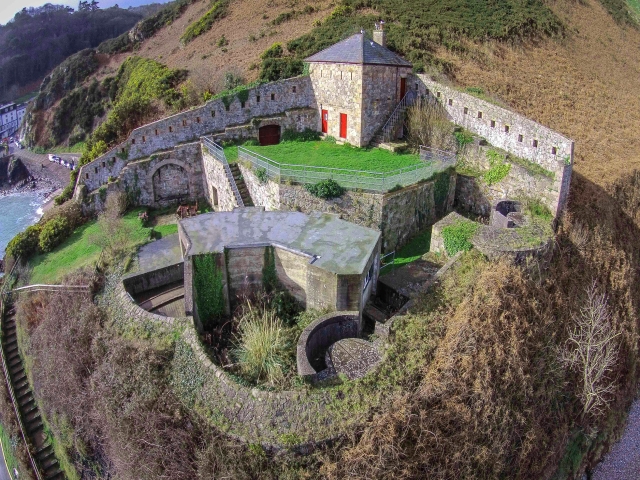 Fort Leicester dates from the mid-16th century, now operated by Jersey Heritage as a holiday
rental. Throughout its history, it never saw action, but instead served as a deterrent against
French invasion in tandem with L'Etacquerel Fort on the opposite side of Bouley Bay, during
the Second World War its impressive vista made it an ideal location for German forces to add
a searchlight position.
Fort Leicester dates from the mid-16th century, now operated by Jersey Heritage as a holiday
rental. Throughout its history, it never saw action, but instead served as a deterrent against
French invasion in tandem with L'Etacquerel Fort on the opposite side of Bouley Bay, during
the Second World War its impressive vista made it an ideal location for German forces to add
a searchlight position. -
Elizabeth castle
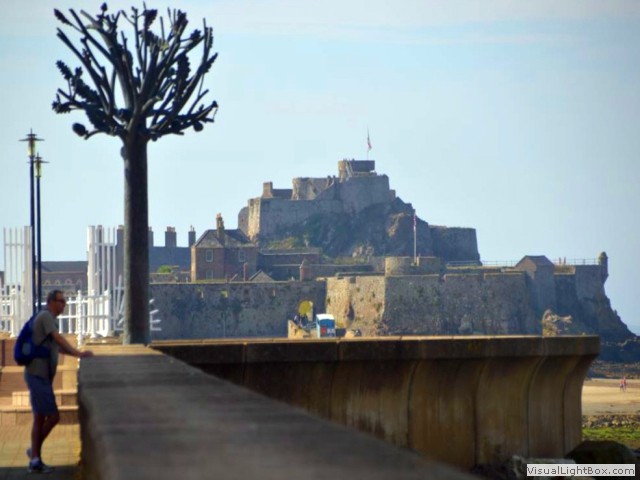 Elizabeth Castle lies half a mile out to sea from St Helier, it can be reached at low tide by a
pedestrian causeway of shingle across the sands or ferries operate at high tide. For 400 years
the island contained a priory, and for the last 350 years a castle. During the Second World War
the Germans modernised the castle with guns, bunkers and battlements.
Elizabeth Castle lies half a mile out to sea from St Helier, it can be reached at low tide by a
pedestrian causeway of shingle across the sands or ferries operate at high tide. For 400 years
the island contained a priory, and for the last 350 years a castle. During the Second World War
the Germans modernised the castle with guns, bunkers and battlements. -
Post war railway
 Following the liberation of Jersey on 9th May 1945 all the railway track was quickly removed. Once the
track had been removed, the route between St Aubin and Corbière was retained for pedestrians, it’s now called
the ‘Railway Walk’.
Following the liberation of Jersey on 9th May 1945 all the railway track was quickly removed. Once the
track had been removed, the route between St Aubin and Corbière was retained for pedestrians, it’s now called
the ‘Railway Walk’. -
Marine Peilstand 1
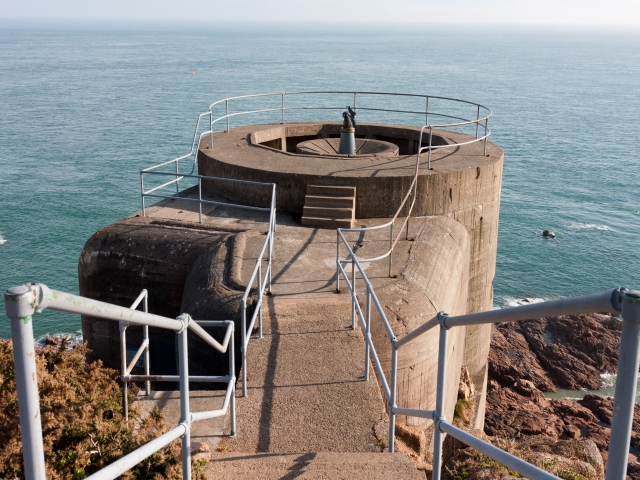 Down some steps was the Marine Peilstand 1 tower, or MP1 tower, it was used to observe targets at sea. The round
tower has four observation floors, each with observation slits set into two metres of concrete, providing
an impressive setting for the distant sea views towards France, it also had one windowless lower floor.
On top of the tower was a mounting for an anti-aircraft gun.
Down some steps was the Marine Peilstand 1 tower, or MP1 tower, it was used to observe targets at sea. The round
tower has four observation floors, each with observation slits set into two metres of concrete, providing
an impressive setting for the distant sea views towards France, it also had one windowless lower floor.
On top of the tower was a mounting for an anti-aircraft gun. -
Ouaisné tower
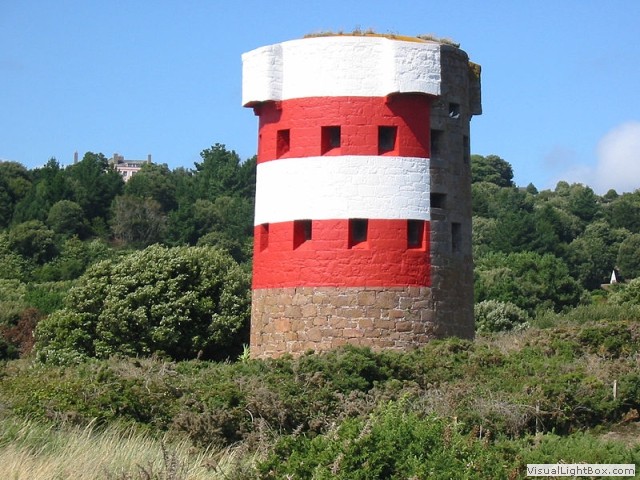 Ouaisné tower was built to ward off French military incursions in the late eighteenth century; today
it’s painted on the seaward side to serve as a navigational aid for ships. The round tower at Ouaisné
is now featured on the rear of the new cherry red £50 Jersey banknote.
Ouaisné tower was built to ward off French military incursions in the late eighteenth century; today
it’s painted on the seaward side to serve as a navigational aid for ships. The round tower at Ouaisné
is now featured on the rear of the new cherry red £50 Jersey banknote. -
La Rocco Tower
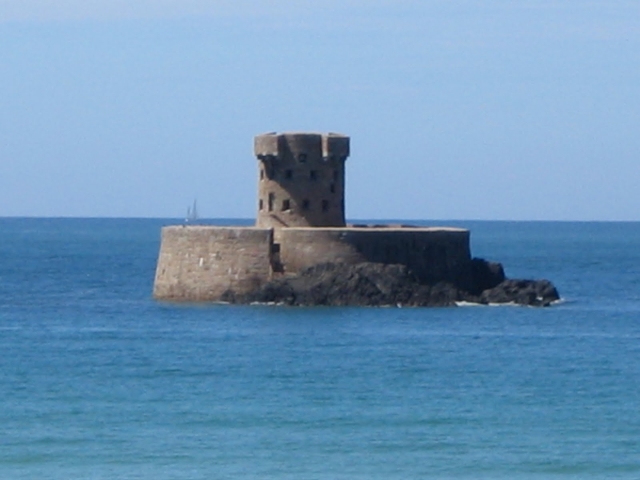 La Rocco Tower stands on a large rock built around 1796, its name is almost certainly derived
from Rocque-hou, meaning rocky island. It was severely damaged either during or shortly after World
War Two, but not through its use as a target for German gunnery practice, as is commonly believed.
La Rocco Tower stands on a large rock built around 1796, its name is almost certainly derived
from Rocque-hou, meaning rocky island. It was severely damaged either during or shortly after World
War Two, but not through its use as a target for German gunnery practice, as is commonly believed. -
The Channel Islands occupation society.
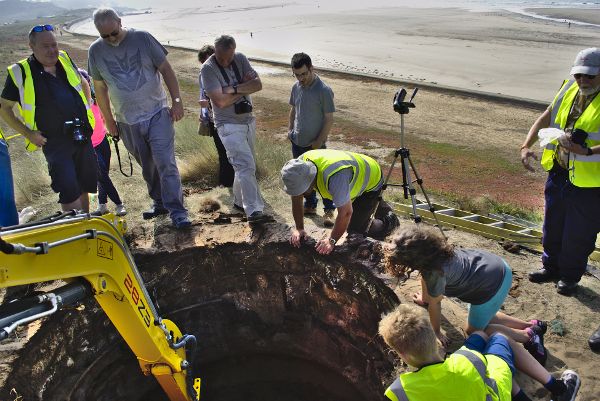 In 2014 the Channel Islands occupation society (CIOS) Jersey dug out the entrance to a WW2 fortification,
they collected parts from inside the rare heavy machine gun turret bunker at St Ouen's Bay. They will
refurbish these and use them in bunkers open to the public like the nearby Sechsschartenturm bunker
below Val de la Mare Reservoir.
In 2014 the Channel Islands occupation society (CIOS) Jersey dug out the entrance to a WW2 fortification,
they collected parts from inside the rare heavy machine gun turret bunker at St Ouen's Bay. They will
refurbish these and use them in bunkers open to the public like the nearby Sechsschartenturm bunker
below Val de la Mare Reservoir. -
Pontins holiday camp Plémont Bay
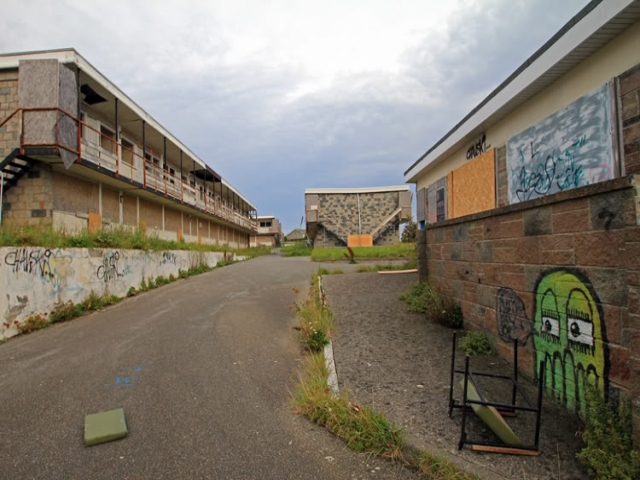 Before the Germans invaded and occupied the island, Pontins tried to colonise Jersey starting with
Plémont Bay. The colossal holiday camp here first opened in the 1920s, and the Nazi's later used it as
a barracks during the war. With the advent of cheaper all inclusive holidays, it closed in 2000, and was
demolished in 2015 by the Jersey National Trust who returned it back to nature.
Before the Germans invaded and occupied the island, Pontins tried to colonise Jersey starting with
Plémont Bay. The colossal holiday camp here first opened in the 1920s, and the Nazi's later used it as
a barracks during the war. With the advent of cheaper all inclusive holidays, it closed in 2000, and was
demolished in 2015 by the Jersey National Trust who returned it back to nature.

 No sooner had the plane taken off
I heard a high-pitched shriek, but it wasn't engine failure, emerging from two rows behind
me was a two foot high screaming banshee. Thankfully the flight was only forty minutes.
No sooner had the plane taken off
I heard a high-pitched shriek, but it wasn't engine failure, emerging from two rows behind
me was a two foot high screaming banshee. Thankfully the flight was only forty minutes. Nicolle Tower was built as a folly in 1821 with a pretty sitting room on the first floor. The
tower has gone through at least three separate phases of construction; most recently in 1943
when the Germans raised the roof by one storey.
Nicolle Tower was built as a folly in 1821 with a pretty sitting room on the first floor. The
tower has gone through at least three separate phases of construction; most recently in 1943
when the Germans raised the roof by one storey. During WW2 the tower served as an important lookout and range finder for the German gun battery
protecting the east side of the island. In the image, you can just see the compass bearings on the ceiling,
and on the walls were approximate distances to targets.
During WW2 the tower served as an important lookout and range finder for the German gun battery
protecting the east side of the island. In the image, you can just see the compass bearings on the ceiling,
and on the walls were approximate distances to targets.  The Seymour Tower was constructed in 1782, built on a rocky tidal island called L'Avarison
and is located 2 km east off the shoreline. Its one of thirty coastal towers planned, however
only 23 towers were built. Jersey Heritage now operates the tower as a holiday rental, but it
hasn't got toilets so you have to bring your poo back with you.
The Seymour Tower was constructed in 1782, built on a rocky tidal island called L'Avarison
and is located 2 km east off the shoreline. Its one of thirty coastal towers planned, however
only 23 towers were built. Jersey Heritage now operates the tower as a holiday rental, but it
hasn't got toilets so you have to bring your poo back with you. One of the 23 Conway towers built, this one was nicknamed the ‘Telegraph tower’ because
a telegraph cable from France came ashore here. It was still an important communications
link during the occupation and was protected by a German resistance nest comprising of machine
gun posts and a bunker (shown above). Just along from here was an interesting private residence
in the shape of a small castle.
One of the 23 Conway towers built, this one was nicknamed the ‘Telegraph tower’ because
a telegraph cable from France came ashore here. It was still an important communications
link during the occupation and was protected by a German resistance nest comprising of machine
gun posts and a bunker (shown above). Just along from here was an interesting private residence
in the shape of a small castle.  Fort Leicester dates from the mid-16th century, now operated by Jersey Heritage as a holiday
rental. Throughout its history, it never saw action, but instead served as a deterrent against
French invasion in tandem with L'Etacquerel Fort on the opposite side of Bouley Bay, during
the Second World War its impressive vista made it an ideal location for German forces to add
a searchlight position.
Fort Leicester dates from the mid-16th century, now operated by Jersey Heritage as a holiday
rental. Throughout its history, it never saw action, but instead served as a deterrent against
French invasion in tandem with L'Etacquerel Fort on the opposite side of Bouley Bay, during
the Second World War its impressive vista made it an ideal location for German forces to add
a searchlight position. Elizabeth Castle lies half a mile out to sea from St Helier, it can be reached at low tide by a
pedestrian causeway of shingle across the sands or ferries operate at high tide. For 400 years
the island contained a priory, and for the last 350 years a castle. During the Second World War
the Germans modernised the castle with guns, bunkers and battlements.
Elizabeth Castle lies half a mile out to sea from St Helier, it can be reached at low tide by a
pedestrian causeway of shingle across the sands or ferries operate at high tide. For 400 years
the island contained a priory, and for the last 350 years a castle. During the Second World War
the Germans modernised the castle with guns, bunkers and battlements. Following the liberation of Jersey on 9th May 1945 all the railway track was quickly removed. Once the
track had been removed, the route between St Aubin and Corbière was retained for pedestrians, it’s now called
the ‘Railway Walk’.
Following the liberation of Jersey on 9th May 1945 all the railway track was quickly removed. Once the
track had been removed, the route between St Aubin and Corbière was retained for pedestrians, it’s now called
the ‘Railway Walk’. Down some steps was the Marine Peilstand 1 tower, or MP1 tower, it was used to observe targets at sea. The round
tower has four observation floors, each with observation slits set into two metres of concrete, providing
an impressive setting for the distant sea views towards France, it also had one windowless lower floor.
On top of the tower was a mounting for an anti-aircraft gun.
Down some steps was the Marine Peilstand 1 tower, or MP1 tower, it was used to observe targets at sea. The round
tower has four observation floors, each with observation slits set into two metres of concrete, providing
an impressive setting for the distant sea views towards France, it also had one windowless lower floor.
On top of the tower was a mounting for an anti-aircraft gun. Ouaisné tower was built to ward off French military incursions in the late eighteenth century; today
it’s painted on the seaward side to serve as a navigational aid for ships. The round tower at Ouaisné
is now featured on the rear of the new cherry red £50 Jersey banknote.
Ouaisné tower was built to ward off French military incursions in the late eighteenth century; today
it’s painted on the seaward side to serve as a navigational aid for ships. The round tower at Ouaisné
is now featured on the rear of the new cherry red £50 Jersey banknote. La Rocco Tower stands on a large rock built around 1796, its name is almost certainly derived
from Rocque-hou, meaning rocky island. It was severely damaged either during or shortly after World
War Two, but not through its use as a target for German gunnery practice, as is commonly believed.
La Rocco Tower stands on a large rock built around 1796, its name is almost certainly derived
from Rocque-hou, meaning rocky island. It was severely damaged either during or shortly after World
War Two, but not through its use as a target for German gunnery practice, as is commonly believed.  In 2014 the Channel Islands occupation society (CIOS) Jersey dug out the entrance to a WW2 fortification,
they collected parts from inside the rare heavy machine gun turret bunker at St Ouen's Bay. They will
refurbish these and use them in bunkers open to the public like the nearby Sechsschartenturm bunker
below Val de la Mare Reservoir.
In 2014 the Channel Islands occupation society (CIOS) Jersey dug out the entrance to a WW2 fortification,
they collected parts from inside the rare heavy machine gun turret bunker at St Ouen's Bay. They will
refurbish these and use them in bunkers open to the public like the nearby Sechsschartenturm bunker
below Val de la Mare Reservoir. Before the Germans invaded and occupied the island, Pontins tried to colonise Jersey starting with
Plémont Bay. The colossal holiday camp here first opened in the 1920s, and the Nazi's later used it as
a barracks during the war. With the advent of cheaper all inclusive holidays, it closed in 2000, and was
demolished in 2015 by the Jersey National Trust who returned it back to nature.
Before the Germans invaded and occupied the island, Pontins tried to colonise Jersey starting with
Plémont Bay. The colossal holiday camp here first opened in the 1920s, and the Nazi's later used it as
a barracks during the war. With the advent of cheaper all inclusive holidays, it closed in 2000, and was
demolished in 2015 by the Jersey National Trust who returned it back to nature.